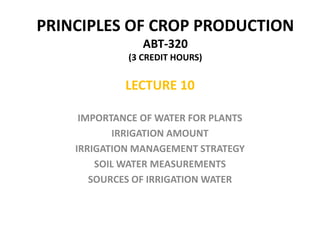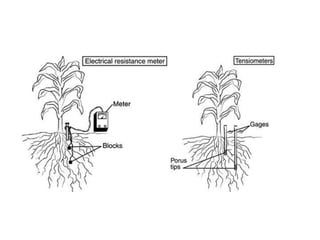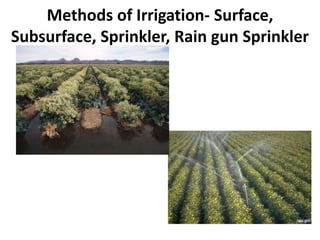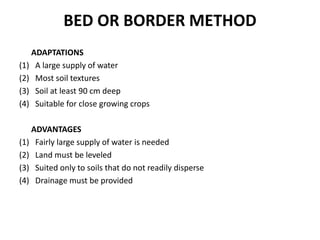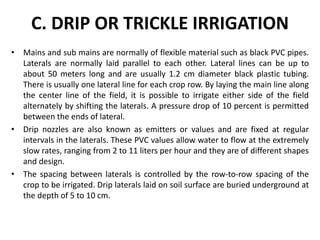lecture-10 (1).ppt
- 1. PRINCIPLES OF CROP PRODUCTION ABT-320 (3 CREDIT HOURS) LECTURE 10 IMPORTANCE OF WATER FOR PLANTS IRRIGATION AMOUNT IRRIGATION MANAGEMENT STRATEGY SOIL WATER MEASUREMENTS SOURCES OF IRRIGATION WATER
- 2. IMPORTANCE OF WATER FOR PLANTS Water is important for plants because of the following reasons: (i) Water helps in the germination of seeds. (ii) Water helps in the process of photosynthesis by which plants prepare their food. (iii) Water helps in the transport of nutrients and minerals from the soil to the plants. (iv) Water helps in the maintenance of the plant structure by providing the appropriate pressure to the plant tissues. (v) Water provides habitat in the form of ponds, rivers, lakes and sea for a large number of plants.
- 3. IRRIGATION AMOUNT ? When possible, the amount of applied irrigation water should be somewhat less than the soil water deficit in order to provide some soil water storage reserve for rainfall. For most soils the net irrigation application during early plant growth and the last few weeks before maturity should be only 30-50 percent of the soil water deficit. This practice will increase the opportunity to store more rainfall and reduce the potential for leaching from normal rainfall events. ? On most sandy soils the irrigation depth should be 80-100 percent of the soil water deficit during the crop's critical growth period . On medium to fine textured soils irrigation application depth should be 50-100 percent of the soil water deficit depending on the irrigation system's pumping capacity.
- 4. IRRIGATION MANAGEMENT STRATEGY ? Deciding when to irrigate to optimize production is a daily judgment decision requiring consideration of several factors by the farm manager. Many of these factors change as the crop develops. Some general guidelines to consider in developing a water management plan and setting allowable soil water deficit limits are as follows: ? In the spring, always make sure the soil in the germination and early growth root zone is moist at the time of planting. If necessary, irrigate to wet this zone. As the plant grows, moist soil is necessary for proper root development as roots will not grow through a dry layer of soil. A dry layer will result in a shallower rooting depth than is desirable. For corn, experience has shown that the soil water deficit can be as high as 60-65 percent in the early vegetative growth stage (germinating to 10th leaf) without affecting plant development. Root zone at this time may only be 1/2 to 2/3 of the crop's potential. Holding back on irrigating during this time promotes deeper root growth, increases the opportunity to store rainfall when it occurs, and decreases the risk for leaching valuable nutrients.
- 5. IRRIGATION MANAGEMENT STRATEGY As the crop nears its critical growth period or its usual peak water use period, the manager's selected allowable soil water deficit should be reduced to minimize the risks of not meeting the crop's water needs and causing economic yield losses. For most crops, this may mean changing to a 30-40 percent soil water deficit limit before entering the critical growth stage--such as the 10-12th leaf stage for corn, or early flower for soybeans. During these critical periods of high water use, projecting the next 2 to 3 days of water needs should be done regularly to plan ahead and avoid stressing any part of the field before it is irrigated. For example, when using a center pivot which takes three days, to cover the field, project what the water deficit will be after three days and use this to determine when to start irrigating. To reduce the leaching potential of a rainfall event, always consider the weather forecast for the next upcoming days in scheduling the next irrigation.
- 6. IRRIGATION MANAGEMENT STRATEGY ? As the crop nears maturity, the soil water deficit generally can be allowed to increase to greater limits without causing stress to the crop. For example, after corn kernels have begun to dent, research has shown that allowing the soil water deficit to increase to 60-70 percent should not reduce yields in most years.
- 7. SOIL WATER MEASUREMENTS ? Two common ways of estimating soil water deficit are by the feel/appearance method or use of soil water sensors. The feel method involves collecting soil samples in the root zone with a soil probe or spade. Then, the water deficit for each sample is estimated by feeling the soil and judging the soil moisture. Soil samples should be taken at several depths in the root zone and at several places in the field. Finally, use these estimated deficits to estimate the total soil water deficit in the root zone. This method requires frequent use by a manager to develop the art of estimating consistently. ? Soil tension is a measurement usually expressed in centibars, and describes how tightly the water is held in the soil profile. It can be measured at any point in the soil profile by the use of sensors such as tensiometers or electrical resistance blocks.
- 9. SOURCES OF IRRIGATION WATER ? Sources of irrigation water can be groundwater extracted from springs or by using wells, surface water withdrawn from rivers, lakes or reservoirs or non-conventional sources like treated wastewater, desalinated water or drainage water. A special form of irrigation using surface water is spate irrigation, also called floodwater harvesting. In case of a flood (spate) water is diverted to normally dry river beds using a network of dams, gates and channels and spread over large areas. ? The moisture stored in the soil will be used thereafter to grow crops. Spate irrigation areas are in particular located in semi-arid or arid, mountainous regions. While floodwater harvesting belongs to the accepted irrigation methods, rainwater harvesting is usually not considered as a form of irrigation. ? Rainwater harvesting is the collection of runoff water from roofs or unused land and the concentration of this water on cultivated land. Therefore this method is considered as a water concentration method.
- 10. Methods of Irrigation- Surface, Surge, Subsurface, Sprinkler, Rain gun Sprinkler
- 11. Methods of Irrigation- Surface, Subsurface, Sprinkler, Rain gun Sprinkler
- 12. Methods of Irrigation- Surface, Surge, Subsurface, Sprinkler, Rain gun Sprinkler There are three principle methods of irrigation viz. surface, sub surface and aerial, overhead or sprinkler irrigation. A. Surface irrigation: There are four variations under this method viz. (1) Flooding, (2) Bed or border method (flat beds), (3) Basin method (ring and basin) and (4) Furrow method (rides and furrows, broad ridges or raised beds)
- 13. FLOODING It consist of opening a water channel in a plot or field so that water can flow freely in all directions and cover the surface of the land in a continuous sheet. It is the most inefficient method of irrigation as only about 20 percent of the water is actually used by plants. The rest being lost as a runoff, seepage and evaporation. Water distribution is very uneven and crop growth is not uniform. It is suitable for uneven land where the cost of leveling is high and where a cheap and abundant supply of water is available. It is unsuitable for crops that are sensitive to water logging. The method is suitable where broadcast crops, particularly pastures, alfalfa, peas and small grains are produced. ADAPTATIONS (1) An abundant supply of water (2) Close growing crops (3) Soils that do not erode easily (4) Soils that is permeable (5) Irregular topography (6) Areas where water is cheap
- 14. FLOODING ADVANTAGES (1) Can be used on shallow soils (2) Can be employed where expense of leveling is great (3) Installation and operation costs are low (4) System is not damaged by livestock and does not interfere with use of farm implements DISADVANTAGES (1) Excessive loss of water by run of and deep percolation (2) Excessive soil erosion on step land (3) Fertilizers and FYM are eroded from the soil
- 15. BED OR BORDER METHOD In this method the field is leveled and divided into small beds surrounded by bunds of 15 to 30 cm high. Small irrigation channels are provided between two adjacent rows of beds. The length of the bed varies from 30 meters for loamy soils to 90 meters for clayey soils. The width is so adjusted as to permit the water to flow evenly and wet the land uniformly. For high value crops, the beds may be still smaller especially where water is costly and not very abundant. This method is adaptable to most soil textures except sandy soils and is suitable for high value crops. It requires leveled land. It is more efficient in the use of water and ensures its uniform application. It is suitable for crops plant in lines. Through the initial cost is high, requires less labor and low maintenance cost.
- 16. BED OR BORDER METHOD ADAPTATIONS (1) A large supply of water (2) Most soil textures (3) Soil at least 90 cm deep (4) Suitable for close growing crops ADVANTAGES (1) Fairly large supply of water is needed (2) Land must be leveled (3) Suited only to soils that do not readily disperse (4) Drainage must be provided
- 17. BASIN IRRIGATION This method is suitable for orchids and other high value crops where the size of the plot to be irrigated is very small. The basin may be square, rectangular or circular shape. Basin irrigation also requires leveled land and not suitable for all types of soil. It is also efficient in the use of water but its initial cost is high.
- 18. BASIN IRRIGATION ADAPTATIONS 1) Most soil texture 2) High value crops 3) Smooth topography 4) High water value/ha ADVANTAGES 1) Varying supply of water 2) No water loss by run off 3) Rapid irrigation possible 4) No loss of fertilizers and organic manures 5) Satisfactory DISADVANTAGES 1) If land is not leveled initial cost may be high 2) Suitable mainly for orchids, rice, jute, etc. 3) Except rice, not suitable for soils that disperse easily and readily from a crust
- 19. FURROW METHOD Row crops such as potatoes, cotton, sugarcane, vegetable etc. can be irrigated by furrow method. Water is allowed to flow in furrow opened in crop rows. It is suitable for sloppy lands where the furrows are made along contours. The length of furrow is determined mostly by soil permeability. It varies from 3 to 6 meters. In sandy and clay loams, the length is shorter than in clay and clay loams. Water does not come in contact with the plant stems. There is a great economy in use of water. Some times, even in furrow irrigation the field is divided into beds having alternate rides and furrows. On slopes of 1 to 3 percent, furrow irrigation with straight furrows is quite successful. But on steeper slopes contour furrows, not only check erosion but ensure uniform water penetration. ADAPTATIONS 1) Medium and fine textured soils 2) Variable water supply 3) Farms with only small amount of equipment
- 20. FURROW METHOD ADVANTAGES 1) High water efficiency 2) Can be used in any row crop 3) Relatively easy install 4) Not expensive to maintain 5) Adapted to most soils DISADVANTAGES 1) Requirement of skilled labor is more 2) A hazard to operation of machinery 3) Drainage must be provided
- 21. B. SUBSURFACE METHOD ? Subsurface irrigation or sub-irrigation may be natural or artificial. Natural sub surface irrigation is possible where an impervious layer exists below the root zone. Water is allowed in to series of ditches dug up to the impervious layer, which then moves laterally and wets root zone. ? In artificial sub surface irrigation, perforated or porous pipes are laid out underground below the root zone and water is led into the pipes by suitable means. In either case, the idea is to raise the water by capillary movement. The method involves initial high cost, but maintenance is very cheap. There is a risk of soil getting saline or alkaline and neighboring land damaged due to heavy seepage. ? It is very efficient in the use of water as evaporation is cut off almost completely. The plant roots do not suffer from logging, there is no loss of agricultural land in laying out irrigation system and implements can be worked out freely. This method is however rarely noticed in our country but followed in other countries like Israel.
- 22. C. DRIP OR TRICKLE IRRIGATION It involves slow application of water to the root zone. The drip irrigation system consist of 1) Head 2) Main line and sub line 3) Lateral lines 4) Drip nozzles The head consists of a pump to lift water and produce the desired pressure (about 2.5 atmosphere) and to distribute water through nozzles. A fertilizer tank for applying fertilizer solution directly to the field along with the irrigation water and filter which cleans the suspended impurities in irrigation water to prevent the blockage of holes and passage of drip and nozzles.
- 23. C. DRIP OR TRICKLE IRRIGATION ? Mains and sub mains are normally of flexible material such as black PVC pipes. Laterals are normally laid parallel to each other. Lateral lines can be up to about 50 meters long and are usually 1.2 cm diameter black plastic tubing. There is usually one lateral line for each crop row. By laying the main line along the center line of the field, it is possible to irrigate either side of the field alternately by shifting the laterals. A pressure drop of 10 percent is permitted between the ends of lateral. ? Drip nozzles are also known as emitters or values and are fixed at regular intervals in the laterals. These PVC values allow water to flow at the extremely slow rates, ranging from 2 to 11 liters per hour and they are of different shapes and design. ? The spacing between laterals is controlled by the row-to-row spacing of the crop to be irrigated. Drip laterals laid on soil surface are buried underground at the depth of 5 to 10 cm.
- 24. C. DRIP OR TRICKLE IRRIGATION ADVANTAGES 1) The losses by drip irrigation and evaporation are minimized 2) Precise amount of water is applied to replenish the depleted soil moisture at frequent intervals for optimum plant growth 3) The system enables the application of water fertilizers at an optimum rate to the plant root system 4) The amount of water supplied to the soil is almost equal to the daily consumptive use, thus maintaining a low moisture tension in soil DISADVANTAGES The initial cost of the drip irrigation for large-scale irrigation is its main limitation. The cost of the unit per hectare depends mainly on the spacing of the crop. For widely spaced crops like fruit trees, the system may be even more economical than sprinkler.
- 25. D. SPRINKLER OR OVERHEAD IRRIGATION ? This method consists of application of water to soil in the form of spray, somewhat as rain. It is particularly useful for sandy soils because they absorb water too fast. Soils that are too shallow, too steep or rolling can be irrigated efficiently with sprinklers. ? This method is suitable for areas having uneven topography and where erosion hazards are great. ? In sprinkler irrigation, water is conveyed under pressure through pipes to the area to be irrigated where it is passed out through or sprinklers the system comprises four main parts: i. Power generator ii. Pump iii. Pipeline and iv. Sprinkler
- 26. D. SPRINKLER OR OVERHEAD IRRIGATION ADAPTATIONS 1) A dependable supply of water 2) Uneven topography 3) Shallow soils 4) Close growing crops ADVANTAGES 1) It ensures uniform distribution of water 2) It is adaptable to most kinds of soil 3) It offers no hindrance to the use of farm implements 4) Fertilizers material may be evenly applied through sprinklers. This is done by drawing liquid fertilizer solution slowly in to the pipes on the suction side of the pump so that the time of application varies from 10 to 30 minutes 5) Water losses are reduced to a minimum extent 6) More land can be irrigated 7) Costly land leveling operations are not necessary and 8) The amount of water can be controlled to meet the needs of young seedling or mature crops.
- 27. D. SPRINKLER OR OVERHEAD IRRIGATION DISADVANTAGES The initial cost is rather very high. Any cost of power to provide pressure must be added to the irrigation charges. Wind interferes with the distribution pattern, reducing spread or increasing application rate near lateral pipe. There is often trouble from clogged nozzle or the failure of sprinklers to revolve. The cost of operations and maintenance is very high. Labor requirement for moving a pipe and related work approximately nearly one hour per irrigation. It is suitable for high value crops.
- 28. THE END
